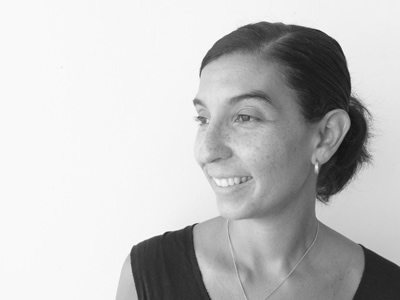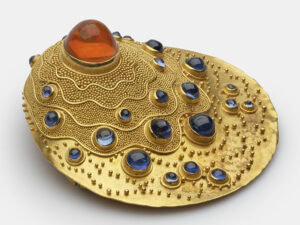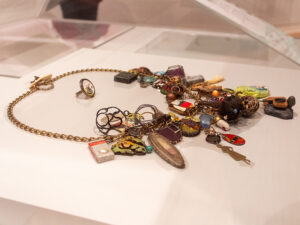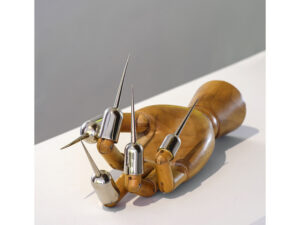A piece of reality, contemporary jewelry as a memory system
February 16–20, 2013
Taller Tierra y Plata, Tlalpan Centro, Mexico City, Mexico
This workshop then traveled to Guadalajara (Mexico), Santiago de Chile (Chile), and San José (Costa Rica). Kamata’s workshop is the second in the series Taller Viajero organized by Otro-Diseño Foundation (Mexico), Walka Studio (Chile), and Novajoia (Brazil). In 2012, Shari Pierce (USA) taught the first one. The third workshop will be held in August, 2013, by Jorge Manilla (Mexico/Belgium) and Tanel Veenre (Estonia).
The Landing
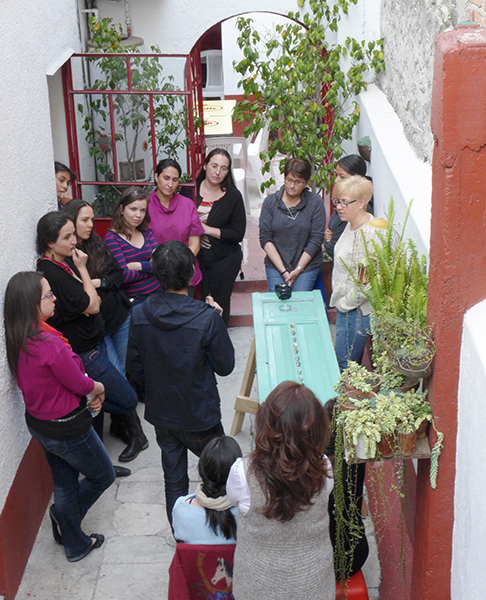
I asked Jiro Kamata what he expected of the workshop. At the time, he was hoping that “all participants had something to find on their own.” Although he was very conscious that a five-day workshop wouldn’t produce pieces finished to the highest standard, he was hoping for participants to find their own path. He wanted to “make them think about why they do jewelry and explain to them why he does it as well.” He felt sure that the workshop’s goals “will be achieved over a long-term period, but that the process of a mutual understanding would be a first step.” I found out that Jiro thinks carefully about what he wants to say—not only because of his cultural background or because we were having a conversation in English, but because he cautiously looks for the exact words to express what he wants to say.
In between Mexican-style eggs and chilaquiles, Jiro was recalling his first visit to Mexico for the Gray Area symposium, where he gave a lecture and had a solo show at Galería Mexicana de Diseño. He told me he “strongly believes that Mexican jewelers are working toward a European way,” but given the long tradition of Mexican jewelers and jewelry, we need not only a concept but also to look at our roots to make very “strong work.” He then remembered when he first arrived in Munich, how easy it was to engage with European culture and its traditions, but after a while, he realized “how important it is to acknowledge where you come from,” to embrace it and appreciate it. He said it was important to know that “not only because you are Mexican you have to do Mexican jewelry,” it has to be more a conscious way of working, and of course, thinking[2]. This research should be the beginning of something to follow up, the starting point of a lifetime’s work.
We then went to our first day at the workshop. Although I didn’t realize it at the time, looking back now I can say he was a little bit anxious. We were 14 women—who wouldn’t be? We had very diverse backgrounds. Some of us were recently graduated design students, some were highly skilled jewelers, ceramicists, graphic designers, architects, and jewelry teachers.
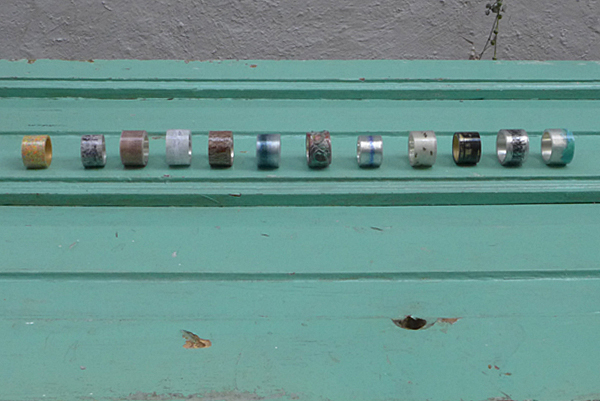
We spent the whole day, from 9:30am until 5:00pm, registering different things in the tape. Jiro came to sit with each one of us. We talked about the different imprints and chose a final one to work with. At the end of the day, we all presented our pieces: Tesa tape rings with sharpened color pencils, expense tickets, black ink, oxide, swear words in ink, hair, and even live ants. It was a warm-up day. For those who were being introduced to contemporary jewelry for the first time, I think it was a good start. They began to relax and engage with the unconventional or “the obvious” as some said. (I have sometimes heard outsiders to the field, those who may not understand it very well, describe contemporary art jewelry as “obvious”—straightforward in the message it delivers or too simple in the way it engages with reality. We all had a laugh, a good time, and most important of all, we warmed up for the next assignment.
The Project
On the second day, we all finally introduced ourselves, talked about what we did, what we liked, and how we were thinking we would engage with the memory theme. We all showed different materials and objects that brought back and activated our personal memories. Then, Jiro gave his second lecture. He talked about the Academy of Fine Arts in Munich, Germany, and his role in it and about the importance of a good display. He had pictures of different shows (his own and that of his students), of his personal work, and of his forthcoming solo exhibition at Galeria Nudo in San Miguel de Allende, Mexico, titled Arboresque. He shared the experience of how he printed approximately 300 photos he took last time he was in San Miguel de Allende and posted them on his studio wall to be able to involve, engage with, and develop this last body of work. Jiro told us how he committed to the arabesque forms, about the long history behind them, and of the link to his Japanese culture. Finally, he showed us the final pieces, how the pictures for the catalogue were taken and why—the whole process. To be able to discover how another artist works, his personal process (not just technical but mental as well) is a rare occurrence. To learn how Jiro Kamata develops new pieces and how he presents them to the public made me question my own working process.
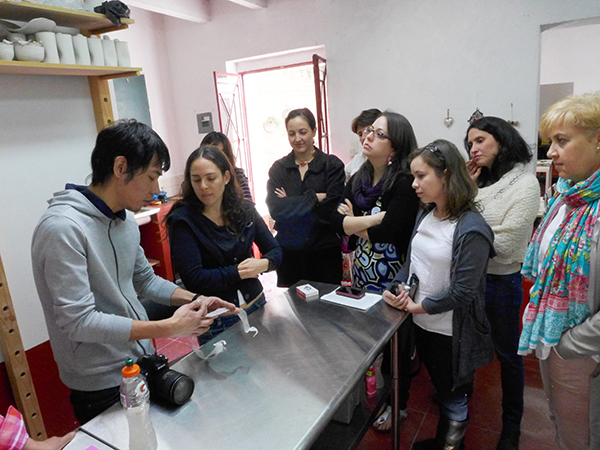
Third day—half the five-day workshop. At Jiro’s request, people continued to experiment with materiality. He had asked participants not to rely on metalsmithing techniques at that point. We were working with familiar objects, some very personal (such as photos and family memorabilia) and others less so, chosen in response to this specific project. Material included coins, nuts, candles and candle wax, earplugs, ceramics, paint, cloth, etc. You could tell some had very good ideas, but they were afraid to explore and propose. Jiro encouraged us. He was specific on the contemporary, theoretical, and experimental approach to the piece. He was always questioning the “why?” and questioning the purpose of it. He didn’t let us return to our comfort zone. He wanted us to explore and discover new ways to address the same idea. He kept on pushing with very subtle questions, very simple ones. He didn’t need many words, just the correct ones to make you wonder and re-think, over and over. In the end, we learned to trust him and read his facial expressions (of which he had many).
On the fourth day, projects started to take shape, and I think that Jiro was more confident that good results were possible. He was always holding his camera and shooting. But at this point, you could tell he was shooting out of sheer interest rather than just recording the moment. By the end of this fourth day, Jiro had talked to each one of us about our project and how it had developed, and of course, encouraged us for the final presentation. It was due by midday of the fifth and final workshop day. We each had chosen a corner or personal space in the vecindad in which to exhibit our work. In the beginning, we were all in the same space around the tables, but we started to get loose, as if we were looking for “spatial identity.” Some went outside, some upstairs, and some in little rooms. I chose a little patio with corona tables[4] to sew and stitch my final project. Each participant engaged in his or her process and final presentation.
Conclusions
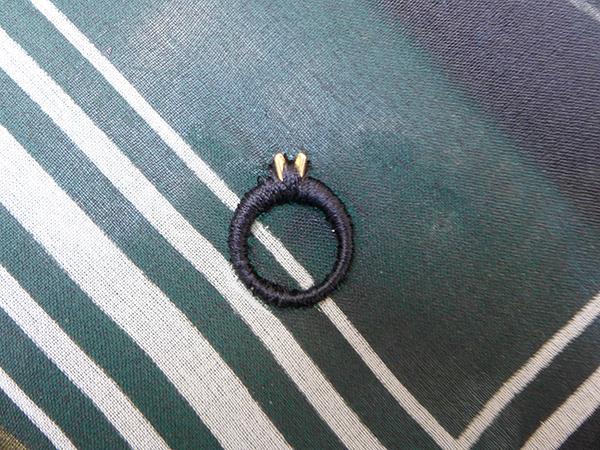
Many struggled with the notion that what we were engaged in making was commercially viable. They could understand that the piece they had produced was a reflection of what they wanted to say, that it was meaningful and well executed. But, they doubted the idea of showing it and selling, and they were not sure it was possible. (This may have had to do with the type of public they are used to addressing.)
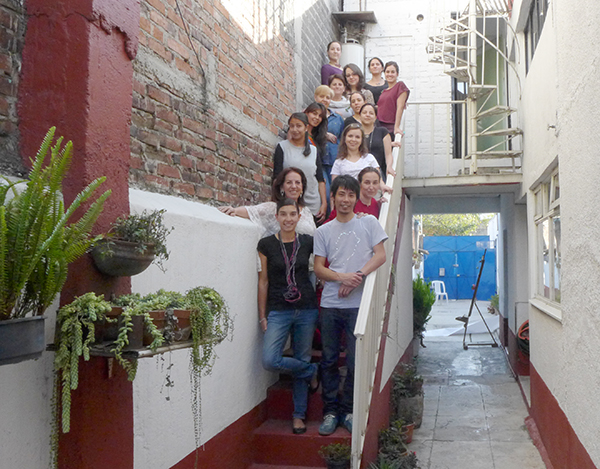
There were a lot of projects, all of them with different degrees of depth. Everyone involved did a lot of exploring with materials and techniques. Some of the participants said that it was their first time working with a concept. Some are coming back for the next workshop, others had a good experience but are not ready to, or interested in, going further into the contemporary jewelry field. But in all cases, the progress from day one to day five was amazing.
In the end, you could tell Jiro was very excited and very satisfied. He told me he was very happy with the results, that he felt the goals were achieved and that for many the seed was planted. I am sure it is not just a seed but also a new pair of spectacles to discover and see the world. For me, it was a very intense five days of thinking, researching, planning, doing, re-thinking, and re-doing. I am looking forward to the next workshop, to see some new faces and some old, to be confronted with new concepts and ideas, and to be challenged again.
[1] A space divided into many little rooms where city dwellers usually live, with a patio and lavaderos (washing area) where women chat and gossip while doing daily laundry by hand.
[2] On the subject of Mexicans doing Mexican work: through the workshop Jiro shared with us his way of working and thinking – the way a Japanese works in Germany, and does Japanese work.
I studied and worked for 4 years in London. I was amazed by the culture, by the history, by the way they taught me, by the artists: I wanted to do what they did. And it wasn´t until I came back to Mexico and looked at my personal roots (which included the Mexican culture, but also my familiar and personal background) that I started to do more personal work, in my very own ‘Mexican’ language.
[3] Workshop presentation, in http://www.otro-diseno.com/tallerviajero/apieceofreality/, accessed on August 5, 2013.
[4] Typical bar tables made by the Corona beer brand.
